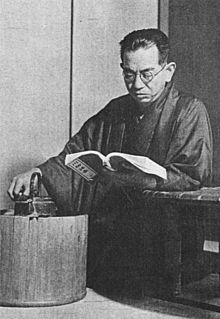Kōgo Noda | |
|---|---|
 Kōgo Noda in 1941 | |
| Born | November 19, 1893 |
| Died | September 23, 1968 (aged 74) |
| Resting place | Tama Cemetery[1] |
| Nationality | Japanese |
| Occupation | Screenwriter |
| Known for | Tokyo Story |
Kogo Noda (野田 高梧, Noda Kōgo, November 19, 1893 – September 23, 1968) was a Japanese screenwriter most famous for collaborating with Yasujirō Ozu on many of the director's films.
Born in Hakodate, Noda was the son of the head of the local tax bureau and younger brother to Kyūho, a Nihonga painter.[2] He moved to Nagoya after completing elementary school and later went to Waseda University.[2][3] After graduating, he worked for the city of Tokyo while also serving as a reporter for Katsudō kurabu, one of the major film magazines, using the pen name Harunosuke Midorikawa.[2] On the recommendation of a scriptwriter friend from junior high, Takashi Oda, he joined the script department at Shōchiku after the Great Kantō earthquake.[2][3] He soon became one of the studio's central screenwriters, penning for instance Aizen katsura (1938), one of its biggest pre-war hits.[2]
He is most known for his collaborations with Ozu, which began with Noda supplying the script for the director's first feature Sword of Penitence (1927), and led to such postwar works as Tokyo Story (1953), regarded by many critics as one of the greatest films of all time. He co-wrote thirteen of Ozu's fifteen post-war films.
When the Writers Association of Japan was formed in 1950, Noda served as its first chair.[4]
- ^ Omura, Daiju. "野田高梧". 歴史が眠る多磨霊園 (Tama Cemetery, where history rests) (in Japanese). Retrieved 2024-05-06.
- ^ a b c d e "Noda Kōgo". Hakodate jinbutsushi (in Japanese). City of Hakodate. Archived from the original on 7 June 2011. Retrieved 29 November 2010.
- ^ a b "Noda Kōgo". Nihon jinmei daijiten (in Japanese). Kōdansha. Retrieved 29 November 2010.
- ^ "Enkaku" (in Japanese). Kyōdō kumiai Nihon shinario sakka kyōkai. Archived from the original on 3 December 2010. Retrieved 30 November 2010.